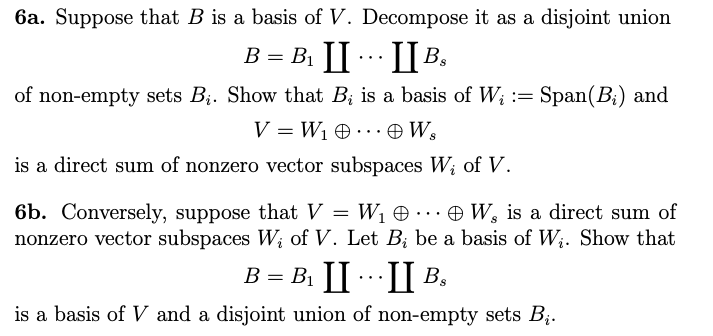6a. Suppose that B is a basis of V. Decompose it as a disjoint union B = B₁ I IIB₂ of non-empty sets B₁. Show that B, is a basis of W; := Span(B₂) and V=W₁ 0... Ws is a direct sum of nonzero vector subspaces W₁ of V. 6b. Conversely, suppose that V = W₁ W, is a direct sum of nonzero vector subspaces W₁ of V. Let Bį be a basis of W;. Show that B = B₁ III B₂ is a basis of V and a disjoint union of non-empty sets B₁.
6a. Suppose that B is a basis of V. Decompose it as a disjoint union B = B₁ I IIB₂ of non-empty sets B₁. Show that B, is a basis of W; := Span(B₂) and V=W₁ 0... Ws is a direct sum of nonzero vector subspaces W₁ of V. 6b. Conversely, suppose that V = W₁ W, is a direct sum of nonzero vector subspaces W₁ of V. Let Bį be a basis of W;. Show that B = B₁ III B₂ is a basis of V and a disjoint union of non-empty sets B₁.
Linear Algebra: A Modern Introduction
4th Edition
ISBN:9781285463247
Author:David Poole
Publisher:David Poole
Chapter7: Distance And Approximation
Section7.1: Inner Product Spaces
Problem 38EQ
Related questions
Question

Transcribed Image Text:6a. Suppose that B is a basis of V. Decompose it as a disjoint union
B = B₁ I
IIB₂
of non-empty sets B₁. Show that B, is a basis of W; := Span(B₂) and
V=W₁ 0... Ws
is a direct sum of nonzero vector subspaces W₁ of V.
6b. Conversely, suppose that V = W₁
W, is a direct sum of
nonzero vector subspaces W₁ of V. Let Bį be a basis of W;. Show that
B = B₁ III B₂
is a basis of V and a disjoint union of non-empty sets B₁.
Expert Solution
This question has been solved!
Explore an expertly crafted, step-by-step solution for a thorough understanding of key concepts.
Step by step
Solved in 3 steps with 3 images

Recommended textbooks for you

Linear Algebra: A Modern Introduction
Algebra
ISBN:
9781285463247
Author:
David Poole
Publisher:
Cengage Learning

Elementary Linear Algebra (MindTap Course List)
Algebra
ISBN:
9781305658004
Author:
Ron Larson
Publisher:
Cengage Learning

Linear Algebra: A Modern Introduction
Algebra
ISBN:
9781285463247
Author:
David Poole
Publisher:
Cengage Learning

Elementary Linear Algebra (MindTap Course List)
Algebra
ISBN:
9781305658004
Author:
Ron Larson
Publisher:
Cengage Learning